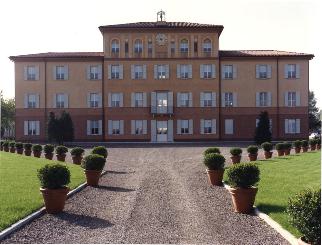
The Headquarter
Italian products are renowned the world over for their style and quality. These characteristics have allowed the Italian ceramic industry to establish an international leadership position.
Given the continuous development of the ceramic industry as one of the most important industrial sectors for both the Italian and the world economies, the Association required a headquarters that would adequately meet the needs of member companies, a prestigious location that would cater for meetings, seminars, presentations, resolution of disputes and press conferences.
In September 1992, the Association left its offices in the Sassuolo old town centre and moved to the Palazzina Ducale di Casiglia on the outskirts of the town, which was seen as a suitable location to reflect the image of the Italian ceramic tile and refractory material industry.
The eighteenth century building stands inside a 76,000 square-metre walled-off garden built in 1560 by Ercole Pio, feudal lord of the Estense family and Signore of Sassuolo. An outstanding example of late eighteenth century architecture, the building underwent a number of modifications over the subsequent two and a half centuries, and recent restoration work has also been carried out by Assopiastrelle. The restoration project was assigned to internationally acclaimed architect Gae Aulenti, who worked alongside other leading professionals with the aim of preserving the original historical and architectural features of the building.
Built on three floors with a total area of 2,490 square metres, the building has a horseshoe structure with two asymmetrical porticoed wings. It houses the offices of the Association itself, EdiCer S.p.a., the Italian Ceramic Industry Documentation Centre (including a Museum and Library), meeting rooms and representation facilities which members can use for important events.
Alongside the Palazzina Ducale di Casiglia, there stands an old farmhouse built between the late nineteenth century and the early twentieth century. This building was recently restored and while maintaining its essential characteristics has been transformed into a conference centre capable of seating 120 people. It is used for members meetings, press conferences and major events.